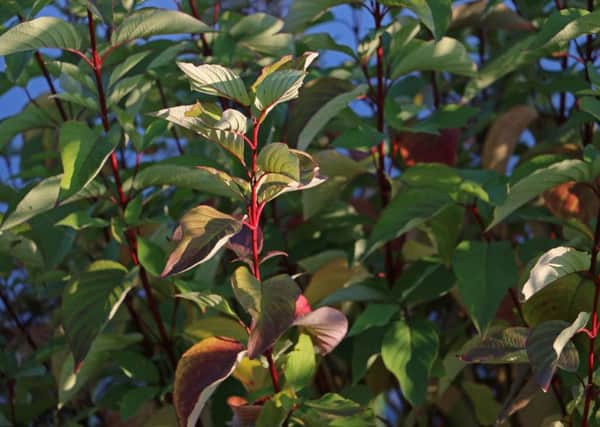GARDENING: Add some late autumn colour with Dogwoods


Leaves have finally fallen and most plants will have become dormant.
In fact, clearing leaves and cutting back dead growth is top of the agenda this month – which is great news because leaves and garden debris are perfect ingredients for homemade compost.
Advertisement
Advertisement
Whilst the glories of summer have long passed there should still be lots of interest in your garden.
Look out for the bright berries of the Cotoneaster or the colourful evergreen foliage of the various Holly varieties, and of course there is always the stunning Dogwood (Cornus).
Dogwoods are reliable and hardy shrubs that not only provide a luscious leafy backdrop to summer flowers but have a rainbow of leaf colours through the autumn and then go on to reveal brilliant wand-like stems.
During winter the brightly coloured stems of dogwoods catch the sunlight to create dazzling displays and although small gardens might only have space for a single plant, in can be positioned where the low winter sun will shine through.
Advertisement
Advertisement
With vibrant stems of intense red, orange and golden yellow it’s no wonder varieties have been given names such as Winter Beauty and Midwinter Fire.
In the summer many shrubby dogwoods carry clusters of tine flowers, usually a creamy-white colour, which often lead on to form dense heads of white berries in autumn.
Dogwoods grow well in almost any soil and are best in a sunny position, but if you want more detailed planting information then visit your local garden centre or nursery where Dogwoods are plant of the moment.
You can also try planting dogwoods in large patio containers to create seasonal displays with a difference, under-planting them with low winter bedding plants or small shrubs.
Advertisement
Advertisement
As the first winter frosts arrive, there are still a few jobs to be done before bedding the garden down for winter, as the gardening experts explain.
David Domoney, TV gardener and presenter, says: “The garden begins to wind down in November, but there are still gardening jobs to do this month to prepare for winter.
“Now is the time move any tender plants into the greenhouse, conservatory or porch to shelter them as frosts can cause serious damage to plants.
“You should also protect any delicate or exotic plants from winter weather with straw and hessian on the crown and around the trunk.
Advertisement
Advertisement
“Bulbs need to be in the ground over winter in order for them to then flower in spring.
“Plant spring bulbs like tulips and daffodils now along with other spring-flowering plants like pansies and wallflowers.”
“Another important winter gardening job is to stake tall plants, climbers and young trees.
“The stakes should be sturdy enough to withstand strong winds.”
Advertisement
Advertisement
Gardener’s World says: “Plant tulip bulbs in pots and borders and cover them with at least twice their depth of soil or compost.
“Take hardwood cuttings from healthy fruit bushes, including currants, blueberries and gooseberries and prune autumn-fruiting raspberries to the ground after harvesting.
“You can continue to mow the lawn in mild spells if the grass is still growing, but raise the height of the blades.
“Don’t forget to check bonfires carefully before lighting to make sure no hedgehogs or other wildlife are sheltering inside.”
Advertisement
Advertisement
If you grow your own, November is perfect for planting new fruit trees and bushes if the ground is not frosted or too wet.
Prune apples, pears and quinces along with red and white currants and gooseberries.
Dig over and weed vacant areas of the vegetable plot incorporating well-rotted organic matter and remove all remaining plant debris.
Do not compost any diseased material.
Now is a good time to get ahead and prepare new asparagus beds for the spring and don’t forget to order seed catalogues for next year.